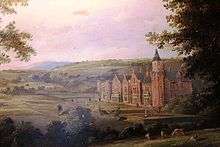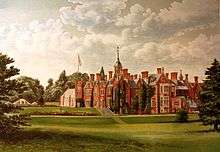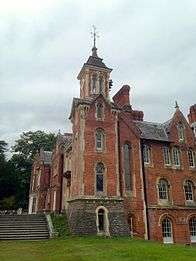The Hendre
| The Hendre | |
|---|---|
|
The Hendre viewed from the east | |
| Former names | Yr Hendre |
| General information | |
| Type | Country house |
| Town or city | Llangattock-Vibon-Avel |
| Country | Wales |
| Coordinates | 51°49′24″N 2°47′13″W / 51.8232°N 2.7869°WCoordinates: 51°49′24″N 2°47′13″W / 51.8232°N 2.7869°W |
| Designations | Grade II* listed |
The Hendre (a farmer's winter residence; literally meaning old home) is Monmouthshire's only full-scale Victorian country house, constructed in the Victorian Gothic style. It is located in the parish of Llangattock-Vibon-Avel, some 4 miles (6.4 km) north-west of the town of Monmouth. Built in the eighteenth century as a shooting box, it was vastly expanded by the Rolls family in three stages throughout the nineteenth century and is most famous as the childhood home of Charles Stewart Rolls, co-founder of Rolls-Royce. The house is Grade II* Listed[1] and is now the clubhouse of the Rolls of Monmouth Golf Club.
Etymology
The Welsh word hendre derives from the Welsh words hen (meaning "old") and dre (meaning "farmstead"). The designation reflects the old Welsh custom of having two residences: one down in the valley, which was used in winter (hendre), and the other homestead in the uplands, where the family would live over the summer (hafod, haf being the Welsh word for "summer".[2][3]
Rolls family
The ascent of the Rolls family to the aristocracy, and to the fortune used to develop the Hendre as the finest Victorian country house in Monmouthshire, was through marriage. James James of the parish of Llanvihangel-Ystern-Llewern, Monmouthshire settled in London and acquired a valuable estate in Southwark, Surrey.[4]

He purchased several farms and parcels of land in Llanvihangel-Ystern-Llewern and Llangattock-Vibon-Avel between 1639 and 1648. In his will published in 1677 he left his estate to his only surviving child, Sarah, who was the wife of Dr Elisha Coysh, a physician from London.[4] Their daughter married William Allen, who also bought land in Monmouthshire.[4] William Allen's daughter and heir married her cousin Thomas Coysh.[4] They were succeeded by their son Richard Coysh, who was succeeded by his sister Sarah (d. 1801), the eventual sole heir of the families of Coysh, Allen and James. Sarah married John Rolls (1735–1801) of the Grange, Bermondsey, and of the Hendre, Monmouthshire, sheriff of Monmouthshire 1794, bringing him much property both in Monmouthshire and London.

John Rolls died the day after his wife. John Rolls was succeeded by his son John Rolls (1776–1837) of the Hendre, who was succeed by his son John Etherington Welch Rolls (1807–70), sheriff of Monmouthshire 1842 (married Elizabeth Mary Long, granddaughter of William Carnegie, 7th Earl of Northesk). He was succeeded by his son John Allan Rolls (1837–1912), sheriff in 1875 and MP for Monmouthshire, 1880–1885, created Baron Llangattock of the Hendre, 1892.
John Allan Rolls's enoblement brought the family, and the house, to its social apogee, culminating in a visit from the Duke and Duchess of York (later King George V and Queen Mary), who stayed with Lord and Lady Llangattock at the Hendre in late October – early November 1900. The Duke and Duchess were taken on motor car excursions by Charles Rolls, probably the first time that the royal couple had been in a car. This was an important event in the family's social history, confirming their elevation to the upper echelons of society.
Of John Allan's three sons, the most famous was Charles, the co-founder of Rolls Royce. As well as his interests in cars and aeroplanes, Charles was a keen balloonist, the Flight Magazine of January 1909 recording a flight from Monmouth:
Ballooning Home. On Saturday last the Hon. C. S. Rolls gave an exhibition of the possibilities of ballooning by taking his mother, Lady Llangattock, home by balloon. The ascent was made at Monmouth in the balloon " Mercury," the occupants of the basket being Lady Llangattock, Hon. C. S. Rolls, Hon. Mrs. Assheton – Harbord, Mr. Claud Crompton, and Mr. Charles Freeman, and the balloon landed on the lawn in front of Lord Llangattock's house, The Hendre.[5]
In July 1910, Charles Rolls was killed when his plane crashed during a flight display at Bournemouth, the first Englishman to be killed in a flying accident.
Lord Llangattock died in 1912. His heir was his first son John Maclean Rolls (1870–1916, dsp.), 2nd Baron Llangattock. He died at Boulogne in 1916 from wounds received at the Battle of the Somme. His younger brother, Henry Alan, having died four months previously, and none of Lord Llangattock's three sons having had children, the direct male line ended and John Maclean Rolls was succeeded by his sister Eleanor Georgiana (d. 1961), wife of John Courtown Edward Shelley.[6]
With the death of Charles Rolls, Henry Allen Rolls and John Maclean Rolls and the extinction of the barony and surname in the male line, the estate passed back up the family through the closest member of the family with surviving descendants, Patricia Rolls, sister of John Allan Rolls. She had married John Taylor Harding of Pentwyn, vicar of Rockfield and Canon of Llandaff, son of John Harding of Henbury and they had four children (John Reginald Harding, Charles Allan Harding, Francis Henry Harding and George Valentine Harding). John Reginald Harding in turn married Elizabeth Margaret Saunders (daughter of Captain John Saunders of Fuzhou, China) and had five children. Upon the extinction of the Rolls branch, the estate came down to his son, John Charles Etherington Harding (born 1898, Xiamen), the first cousin once removed of the 2nd Baron Llangattock, who inherited the house, estate and surrounding farmland, changing his family name to Harding-Rolls for this purpose.


The Harding-Rolls branch of the family continued to live at The Hendre until 30 August 1984 when, following a failed time-share operation, it was sold to Effold Properties Limited. The mansion is presently the club house to The Rolls of Monmouth golf course.
Mansion
History
The mansion began as a shooting lodge, for John Rolls (1776–1837), and the original manor house was expanded throughout the next one hundred years. The first of three expansions by the Rolls family began with the architect George Vaughan Maddox, who rebuilt parts of the south wing in 1830. John Rolls's successor, John Etherington Welch Rolls, continued the mansion's development, using Thomas Henry Wyatt as his architect. Wyatt extended the house in the period 1837–41, creating the great hall and improving the park, including the addition of the gate lodges on the Monmouth Road, and he continued the enlargement of the south wing, both to the east and to the west, between 1837 and 1858.
In 1872, the development began again with the removal of the old stables and the building of the present Coach House and loose boxes. At the same time, the core of the present house, being the Billiard Room, Smoking Room and Dining Room, were added. These final two stages of expansion were undertaken by John Etherington Welch Rolls's son, J. A. Rolls. Raised to the peerage as 1st Baron Llangattock, Rolls employed first Henry Pope, who completed the dining room wing and, secondly, Sir Aston Webb, who added the Cedar Library.
Immediately after the Second World War a private boys' boarding school was briefly established at The Hendre. Ardmore School catered to British and foreign students with a Dr Jones as headmaster. The school appears not to have flourished, as the London Gazette of 20 December 1949 lists Dr Jones, "present address(..)unknown, lately residing at and carrying on business at Ardmore Private School, The Hendre.." for a bankruptcy hearing.[7]
Description
"The Hendre, a handsome mansion of brick and stone, in the Norman and Tudor styles."[8] The house is constructed of red brick, dressed with Bath stone and comprises a courtyard bounded to the west by a low wall and on the three other sides by ranges of buildings. Above the porch is carved a motto, so beloved of the Victorians, reading "Open House Open Heart". The decoration is flamboyantly neo-Norman, "gargoyles and grotesque animal corbels (breaking) out wherever one looks."[9] The front has two storeys and seven bays, the second, third and fourth belonging to the house of the 1820s. To the east, the scale and grandeur of the dining room range demonstrates J. A. Rolls's "escalating ambitions." [10] Lastly, the wing added by Sir Aston Webb from 1896, comprising the Cedar Library and the later service wing, represents the house at its social and architectural peak.

The interior reflects the house's expansion, as the wealth and influence of the family increased, from the small but highly decorated rooms of the 1820s, through to the Great Hall of 1858, and lastly the dining room suite and the Cedar Library of its late Victorian/Edwardian apogee.
For all its antique, neo-Norman decoration, the house was technologically very advanced, the service court including "a gas-making house and an electricity-generating house to power the mechanisms which made The Hendre in Lord Llangattock's time a throughly forward-looking estate."[11] In his book, "Black Mountains: The Recollections of a South Wales Miner", David Barnes notes his grandfather recalling that 'The Hendre had been the first house in Monmouthshire to have a telephone when John Allan Rolls installed a Gower Bell loud-speaking telephone in the house in May 1881.'[12]
Gardens
"The Hendre is the grandest and most important Victorian park and garden in Monmouthshire".[13] Although a golf-course is now superimposed upon much of the parkland, resulting in the unfortunate neglect of much of the gardens, they still remain an essential example of late nineteenth/early twentieth-century garden design, demonstrating the high levels of design and landscaping, conducted mainly by Lord Llangattock towards the end of the 19th century,[14] which accompanied the construction and enlargement of the house. The estate boasts an arboretum, stocked with specimen trees (including several ancient oaks), a landscaped lake with an artificial cascade created by James Pulham & Co. and three long drives, the most impressive designed by H.E. Milner in the 1890s. In its heyday it also contained formal sunken gardens with cast-iron fountains, pavilions, a boathouse and a parterre. The walled kitchen garden is one of the best preserved in Wales, containing two original greenhouses still in good condition. An article in the Gardeners' Magazine of 1903 described the park thus; "The Hendre stands in a finely wooded park of a thousand acres’ extent, and is reached from the county road by a long drive of about two miles (3 km). This drive was made by Mr H.E. Milner (son of landscape gardener Edward Milner), from his Lordship’s own designs [Lord Llangattock]. It passes through plantations of the finest conifers, winding upward by easy gradients through oak wood and copse, revealing here and there broad stretches of open park bedded with bracken and peopled with herds of deer."[15] The granary and attached barn, the stable block, the rose garden pavilion and fountain pool, the bridge and the Box Bush lodge at the park entrance are all Grade II Listed.[1]
Gallery
 The Great Hall of the Hendre with hammerbeam roof created between 1837-1841
The Great Hall of the Hendre with hammerbeam roof created between 1837-1841 Window in the Cedar Library built by Sir Aston Webb, featuring the arms of Baron Llangattock
Window in the Cedar Library built by Sir Aston Webb, featuring the arms of Baron Llangattock View of the Hendre from the main lawn to the south
View of the Hendre from the main lawn to the south Close up view of the clock tower, restored to working order by Rolls-Royce Limited
Close up view of the clock tower, restored to working order by Rolls-Royce Limited
Notes
- 1 2 British Listed Buildings Online
- ↑ "Life on the Land". The National Library of Wales. Retrieved 31 March 2012.
- ↑
- 1 2 3 4 "Gwent Record Office, Documents relating to the Rolls family, barons Llangattock, of The Hendre". Archives Wales. Retrieved 22 December 2010.
- ↑ "News of the Week: Ballooning Home". Flight. London, UK. I (1): 5. 2 January 1909. Retrieved 13 March 2015.
- ↑ Gwent County Records Office: Reference code(s): GB 0218 ROLLS D361
- ↑ The London Gazette 20 December 1949
- ↑ Kelly's Directory of Monmouthshire: 1901
- ↑ Newman, p. 251
- ↑ Newman, p. 252
- ↑ Newman, p. 255
- ↑ Barnes David, Black Mountains: The Recollections of a South Wales Miner – p.15
- ↑ Elisabeth Whittle, Welsh Historic Gardens Trust: Bulletin Autumn 2003
- ↑ "The Hendre, Gardens, Llangattock-Vibon-Avel | Site Details". Coflein. Retrieved 2012-02-12.
- ↑ The Gardeners' Magazine, September 26th, 1903
References
- Newman, John (2000). Gwent/Monmouthshire. The Buildings of Wales. Penguin. ISBN 0-14-071053-1.
- Joseph Alfred Bradney, "A History of Monmouthshire, Part I. The Hundred of Skenfrith." (1904) Mitchell Hughes and Clarke
External links
- The Rolls of Monmouth Golf Club
- Welsh Historic Gardens Trust
- Charles Rolls with the Duke and Duchess of York
- Gwent Archives